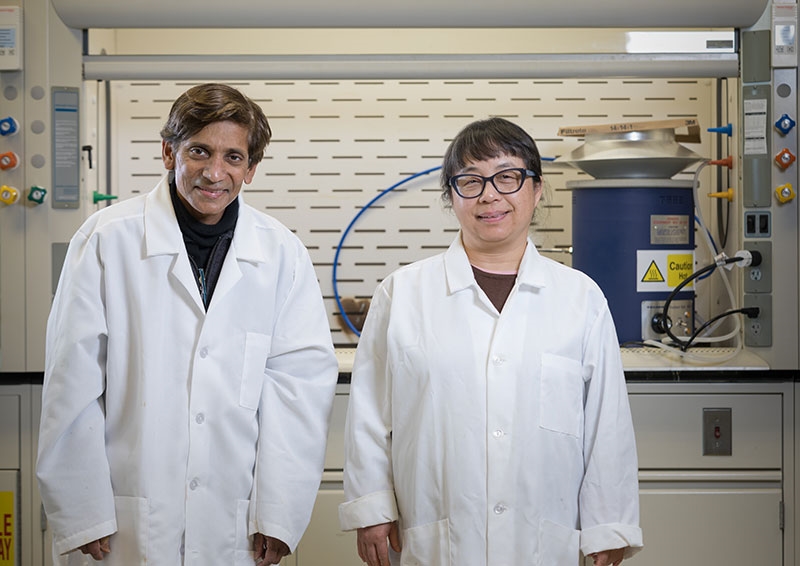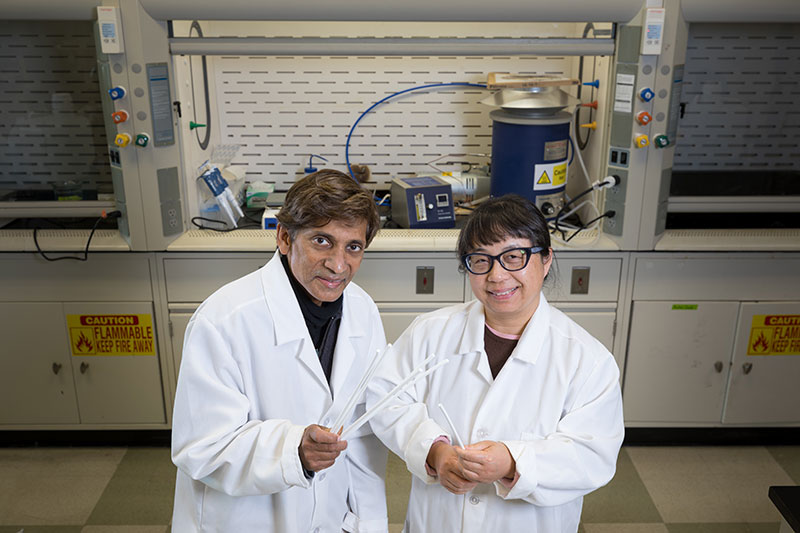
Xianghong Qian and Ranil Wickramasinghe first met in 1991 through a mutual friend and classmate, respectively. At the time, Wickramasinghe was earning his Ph.D. in chemical engineering at the University of Minnesota, and Qian was earning her Ph.D. in physical and theoretical chemistry at George Washington University. They hit it off and married in 1996, while still residing in separate states. It wasn't until 2000 that they finally resided in the same city at the same time — fully nine years after they met and four after they married.
This illustrates the challenging life of the itinerant academic in pursuit of the next degree, the next postdoctoral opportunity, the next academic appointment. It's all the more challenging for immigrants far from home, who lack the family support, social network and professional contacts an American-born academic may have.
While the couple found a home at Colorado State University for several years, it wasn't until 2011, when Wickramasinghe became one of the first two Arkansas Research Alliance Scholars, that they really found a lasting home — in Fayetteville, Arkansas.
Wickramasinghe was named the Ross E. Martin Chair in Emerging Technologies in the Department of Chemical Engineering while Qian was awarded the Robert E. Babcock Sr. Professorship in Chemical Engineering, though she moved to the biomedical engineering department two years later. She noted that both spouses in the same department can be limiting, "because people can see you as one entity, not as separate entities, so that can make you feel not as relevant." By moving to biomedical engineering, Qian was able to forge her own professional identity.
And that was when the couple's professional collaboration truly kicked into high gear. Their catalytic membrane reactor for biomass conversion to biofuel was funded by the National Science Foundation in 2013. They filed their first patent in 2015, with five more coming since then (only one, filed last year, is still pending). They have also published roughly 60 papers together, mostly in the last 10 years, and founded a company based on their research, SIEV Technologies. While both still have separate research interests, now and in the past, the primary focus of their work together is in membrane science and engineering.
Wickramasinghe is the executive director of the Membrane, Science, Engineering and Technology Center, a cooperative research center currently consisting of four affiliate universities. Broadly stated, his research focuses on synthetic membrane-based separation processes for purification of pharmaceuticals and biopharmaceuticals, the treatment and reuse of water, and for the production of biofuels.
Wickramasinghe noted that when he was a doctoral student, he had an adviser that he "got on very well with. He was quite a unique character at the university. The first project was very interesting because it was on designing blood oxygenators for open heart surgery."
From there Wickramasinghe worked in private industry for five years, designing membranes with biomedical applications. Once he moved to Colorado State University, his work took a more environmental turn, including better ways to recycle and reuse water as well as the design of catalytic membranes to convert waste biomass into bio-based products.
It took Qian a little longer to get into membrane research, mostly focusing on it since her arrival in Arkansas, though when she was in Colorado she spent some time working on biomass conversion at the Nation Renewable Energy Lab in Golden. She is an expert at using computational chemistry methods, including discovery of a new catalyst that can convert biomass to sugars that are then fermented into biofuel. More recently, she has studied purification methods for biopharmaceuticals. In particular, Qian is developing cost-effective methods to recover and purify virus particles for applications in gene therapy and viral vaccines. This work has the potential to reduce the cost and time required to bring these emerging therapeutics to the market. She is also a site co-director of the MAST Center, along with Wickramasinghe.
Andrew Zydney, a chemical engineering professor at Pennsylvania State University, recently joined the MAST Center as PSU's site director. "I was particularly impressed with the work that Ranil and Xianghong had done to increase the scope of the center by adding several biopharmaceutical companies to the Industry Advisory Board," Zydney explained. "My own research is focused on the applications of membranes in bioprocessing, so the opportunity to join the center, and to collaborate on projects with Ranil and Xianghong, was very exciting. Joining the MAST Center has been a great experience, and Ranil's leadership has been absolutely critical to the center's success."
In the simplest terms, Qian focuses on catalyst design while Wickramasinghe focuses on membrane separation. After being mixed with a catalyzing agent, biomass, like corn fiber, is broken down in a reactor, and then pushed through a membrane, separating out the biofuel. Their goal is to identify the best catalyzing agent as well as the best membrane design. The membranes (see photo) are actually ceramic tubes made of silicon oxide, and can be bundled together as needed to increase output.
 David Hurley holds a solution of catalyzing agent and corn-fiber. |
That's the underlying research behind SIEV Technologies, a catalytic membrane reactor design company founded by the researchers in 2020. Last year, the fledging company was awarded a $256,000 Small Business Innovation Research Grant from the National Science Foundation to further develop technology that improves biofuel production. The grant will enable SIEV to continue developing its business model as well as its technology. SIEV will initially focus on ethanol production. While there are only around 200 ethanol production plants in the country, Wickramasinghe described it as "a beachhead market, representing the shortest path to commercialization for the company."
David Hurley, an engineer with SIEV, moved to Fayetteville from southern Ohio. He said that when he was considering the job, he was looking at a number of positions across the country and didn't want to take the first job offer. His decision would be based on three things he thought were important: "The job needed technology that seemed viable; it needed what were clearly highly renowned experts in their field, and it needed the right team." Hurley felt the first two were in place, but the third was still coming together. But what finally sold him was "I heard one of them say 'y'all' and thought, 'I'm not going to be judged for my accent if I go there.'" He signed on in September of 2021.
With so many mutual interests, it can be a challenge to separate work from home, especially when they may have spent the day in different labs, working on problems of mutual interest. One thing they like to do is take trips that are not work related. They also have a son, Aroshe, who has enabled Qian to slow down and delve deeper into U.S. culture as Aroshe has grown into an American teenager.
While the couple have settled into Northwest Arkansas — the longest they have lived anywhere in the U.S. — being immigrants can still be challenging. Wickramasinghe was born in Sri Lanka, but grew up in Melbourne, Australia, where his father, who was a surgeon, did his residency. Qian was born and raised in Wuxi, China. All of their parents still live in their home countries, though they are all around the age of 90, which makes their ability to travel to the U.S. more difficult. Prior to the COVID-19 pandemic, a family vacation might involve Wickramasinghe taking Aroshe to Australia for a visit, then flying to China to meetup up with Qian and her family. Needless to say, pandemic has made getting around more difficult, especially for a couple who enjoy travel.
Ultimately, the couple see themselves as having different but complementary strengths. Qian is the theoretical thinker, Wickramasinghe the practical engineer, picking out the most workable ideas. Qian explains, "As a theoretician, I like brainstorming ideas. Sometimes when I am talking out loud, I don't even think about trying to do something. But I can remember a lot of things Ranil actually put into plans. He's very good at execution."

Ranil Wickramasinghe, left, and Xianghong Qian hold ceramic membranes, tubes made of silicon oxide.
Topics
Contacts
Hardin Young, assistant director of research communications
University Relations
479-575-6850, Hyoung@uark.edu